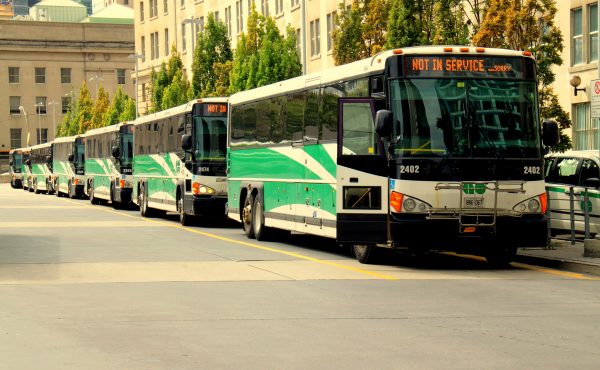
REYKJAVIK, ICELAND — Like most countries who suffered through the oil crises of the 1970s, Iceland has taken big steps to alleviate it’s dependency on foreign energy resources. It has now become a world leader in hydro electricity while pushing the envelope on alternative forms of energy like geothermal and tidal power. Heating a home is rather cheap here, which explains all the drafty, single-paned windows I’ve experienced. But oddly enough, Reykjavik is a car-oritented city through-and-through.
Reykjavik, though nearly 1,000 years old, is very much like a Canadian city: a dense urban centre surrounded by sprawling suburbs. When I ventured out, either into the central core or to the waterfront edges of town, I found traffic jams.

I rented a car early in my trip with my travelling partner Nick — who also happens to be a Spacing contributor and my longest serving close friend, dating back over 30 years to our kindergarten class (Need proof? Check out my 8th birthday party photos). We were seriously jet-lagged and were regularly waking up at the crack dawn. We figured getting out for a drive at sunrise to view the natural scenery would be a good antidote. We were able to see some of the famous geysers and the amazing Gull Foss waterfalls (see the larger, five image panorama on Flickr). I also got to walk through the continental divide of the North American and European tectonic plates which are consistently pushing away from each other at two-inches a year.
Reykjavik doesn’t really have any highways, just a few large(ish) arterial roads heading out in all directions east. While it took only a few minutes to get out of the dense urban core, the suburbs went on for about 30 minutes. Big box stores were surprisingly rampant. And in some cases, suburban developments have stopped completely due to the economic crisis.
None of these roads were tolled, unlike other countries in Scandinavia. The lack of road pricing may be compensated by the astronomical price of gasoline: to fill one-third of a tank cost me $40 Canadian. And more odd was the speed limit: the highest I experienced was only 90km/h, and that was in a rather remote part of the southeast. This kind of speed makes for inefficient gas consumption in a country priding itself on being fossil fuel-free within the next decade.

photo by Luc Van Braekel
As I mentioned in my previous post, Iceland experienced a large economic boom through much of the last 20 years which created a huge demand for housing and development. Up popped the sprawling suburbs. But the one thing I preferred about Reykjavik’s ‘burbs over Toronto was the variety of shapes and forms of the housing stock. Most developments were low-rise apartments and condos that didn’t resemble the building next to it. I saw circle-shaped row houses with central courtyards; a slew of high-rises (no more than 15 or 20 storeys) that weren’t made of only glass and steel but with attractive geometric shapes and designs; and it seemed residents and developers like to add dramatic splashes of colour to roofs or facades. Also, almost all homes were clad in corrugated metal, including roofs — due to the salty ocean water spraying inland — with the older homes covered in a cement stucco. I only saw wood or brick used far inland, and that seemed to be on wealthy vacation homes.


Back in Reykjavik, there were only a few signs of progressive thinking towards sustainable transportation: there were a few parking spots dedicated solely to electric cars with a battery charger at curbside. Bikes didn’t seem to be a widely used, though this may have something to do with Reykjavik having a consistently rainy climate as well as being as hilly as Vancouver. While the city had a fair amount of space for bike parking, next to none of it was used. Maybe the summer months bring out the two-wheelers, but there were very few signs of such a bike culture and even fewer dedicated bike lanes. We even arrived on the first day of Spring, which they call the “warm weather” season and celebrate with a national holiday.


I didn’t have any need to take public transit while in Reykjavik, but it seemed to be widely used. There is only a bus system in Reykjavik as the geology of Iceland, which still has considerable seismic activity, is made up almost entirely of lava bedrock, and is not suitable for underground transit. The country’s total population slightly exceeds 300,000 with 50% living in the greater Reykjavik area. Tram and LRT might be a good option for the suburbs, but more walkable communities and increased density would have to improve for it to be successful.

One of the more interesting public transit tidbits I noticed were the signs displaying bus schedules: they rotated around the bus stop pole. I’m not too sure if this is practical, but I found it charming. Reykjavik also deployed a modest yet modern style of bus shelter in the core of the city (seen below, top), which seems to be replacing a more industrial type of shelter (seen below, bottom) still found in areas further from the core.


photos by Matthew Blackett, unless otherwise noted
– – – – – – –
Spacing publisher Matthew Blackett is travelling through Iceland, Denmark, Sweden and Germany over the next month and will occasionally post his observations about all things important to Spacing.




8 comments
Thanks for sharing, this whole Iceland series is really interesting to see. I’m hoping to travel there sometime in the summer, finances permitting. Looking forward to the rest of your Scandinavian travels!
I notice the ad space in the bus shelters. Were they used for regular commercial advertising, or just the political campaign ads?
Interesting stuff.
One quibble – I’m pretty sure you’re wrong about the speed limit point. Google “fuel economy km/h” or anything to that effect and you’ll find most studies find cars are more fuel-efficient at 90 km/h (even lower in some cases) than at expressway-type speeds.
90km/h is a very efficient speed for a car can travel at.
Hi Matt,
Nice pics. What are people doing for work/food etc? From here in the states it seemed that the whole country was going to implode.
Thanks,
HG NYC
Maybe my wording is a little off: I experienced 90km in a remote spot whereas the “highways” in RJK were all 70km/h. Most of the highways were 70 in the countryside, sometimes 80.
It’s also worth mentioning: due to the volcanic nature of the island, the main streets and roadways inside Reykjavik are HEATED, which means when it snows (and I’ve seen this with my own eyes), the roadways and stay dry — no need for harmful salt!
This made me think of something that is occurring in the Cell Phone industry and is long overdue and that’s a standard connection. I’ve not read a single article on plug in electric cars about what kind of connector is required to plug in and recharge. It would make sense that a standard would be put in place but highly unlikely knowing the way the auto industry works.